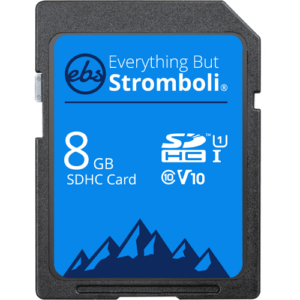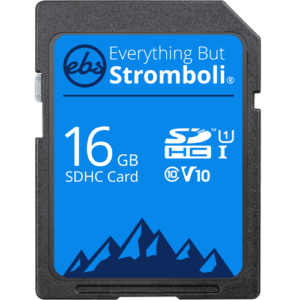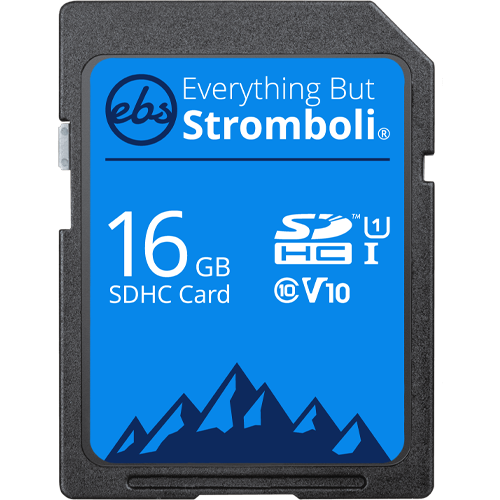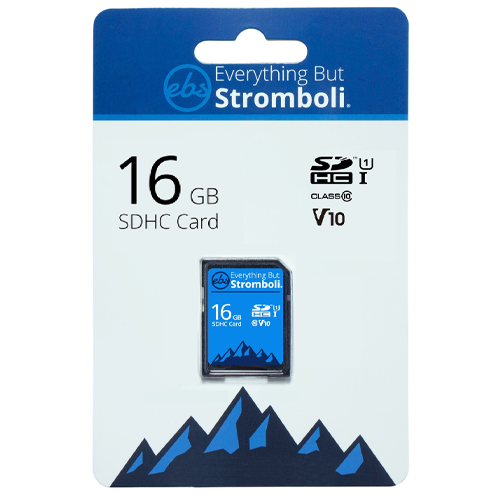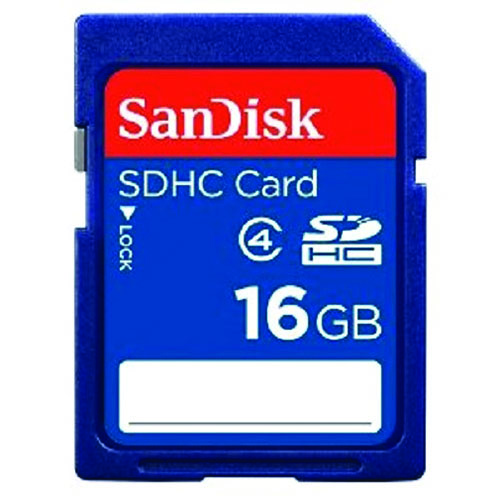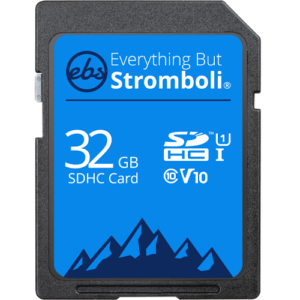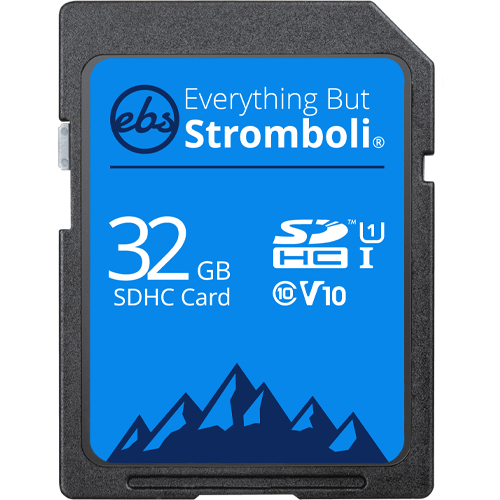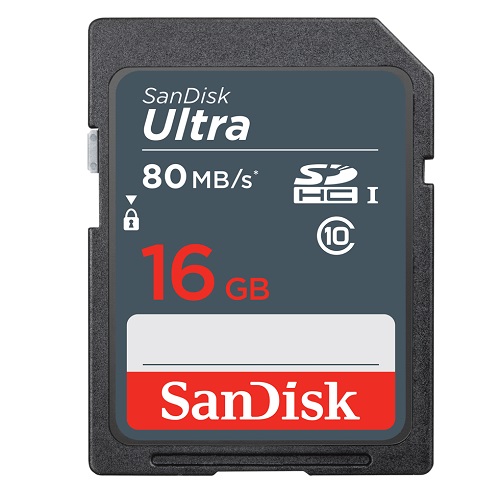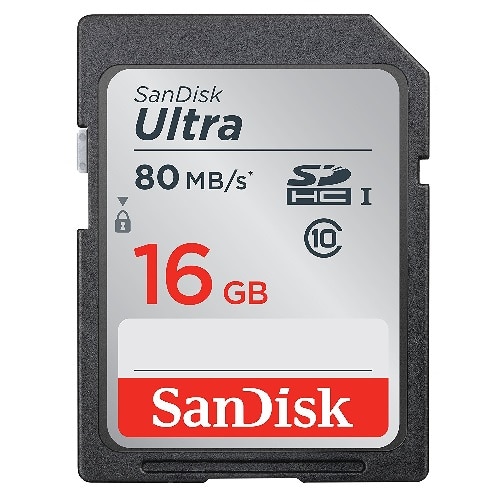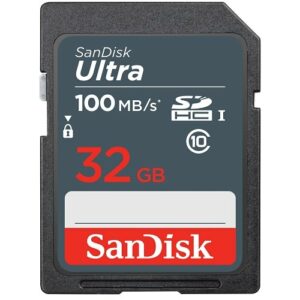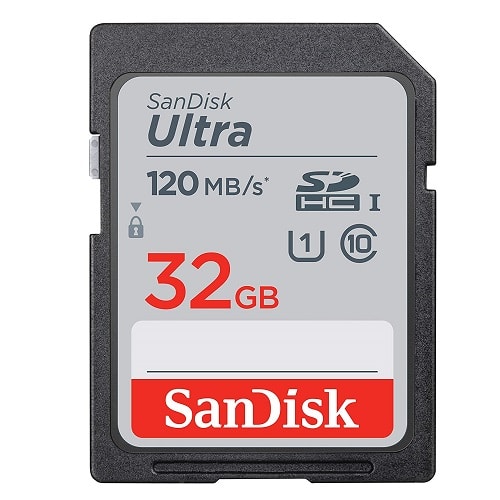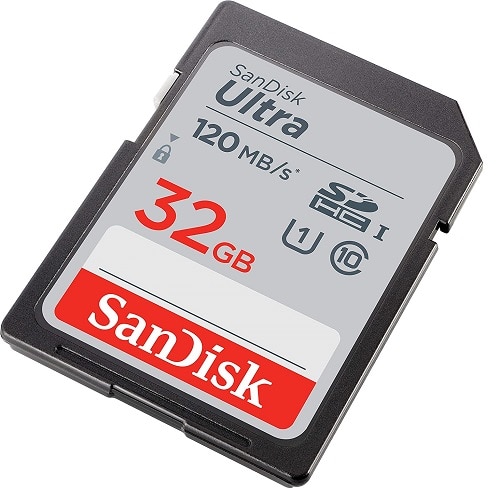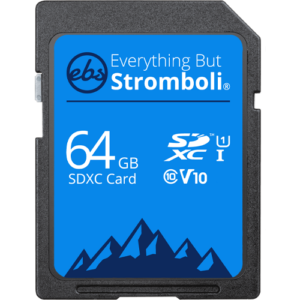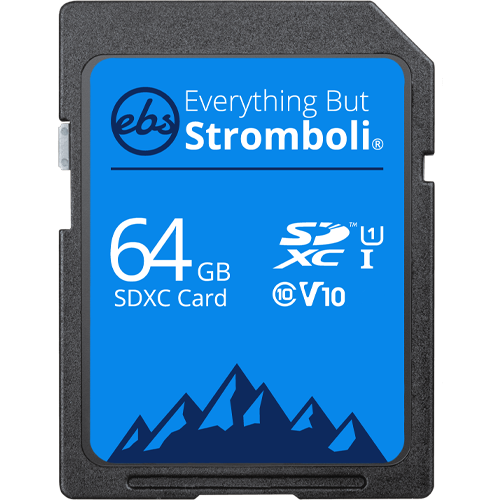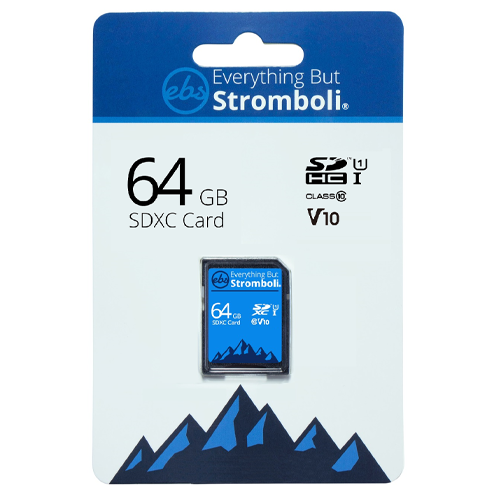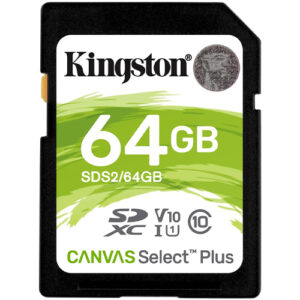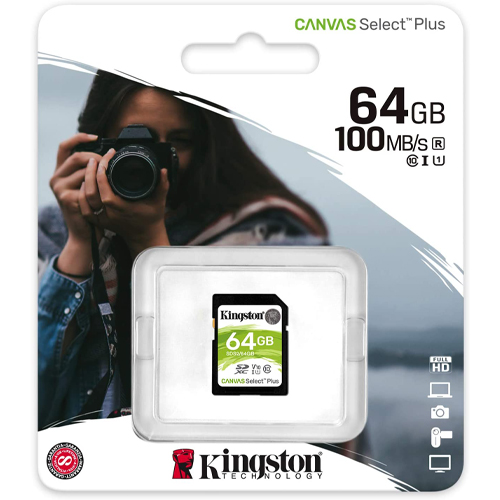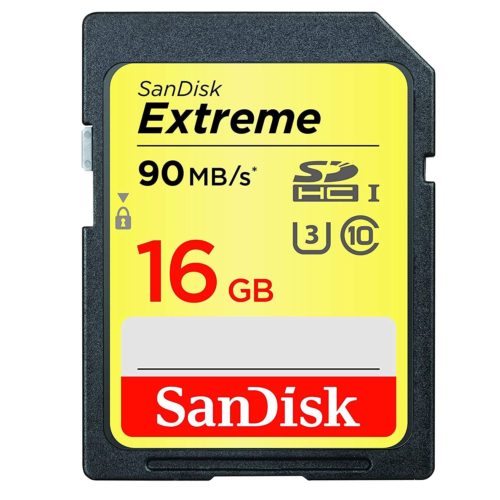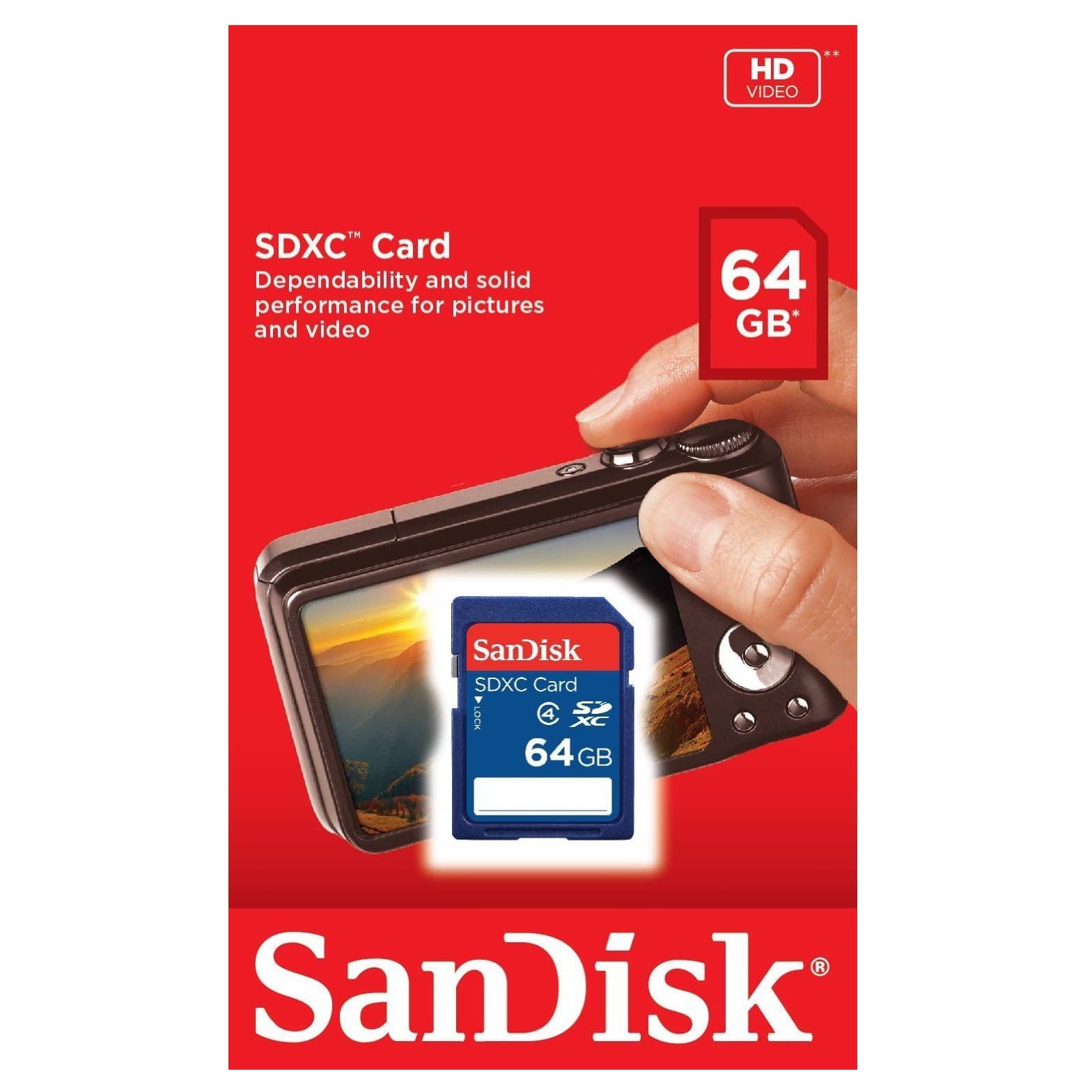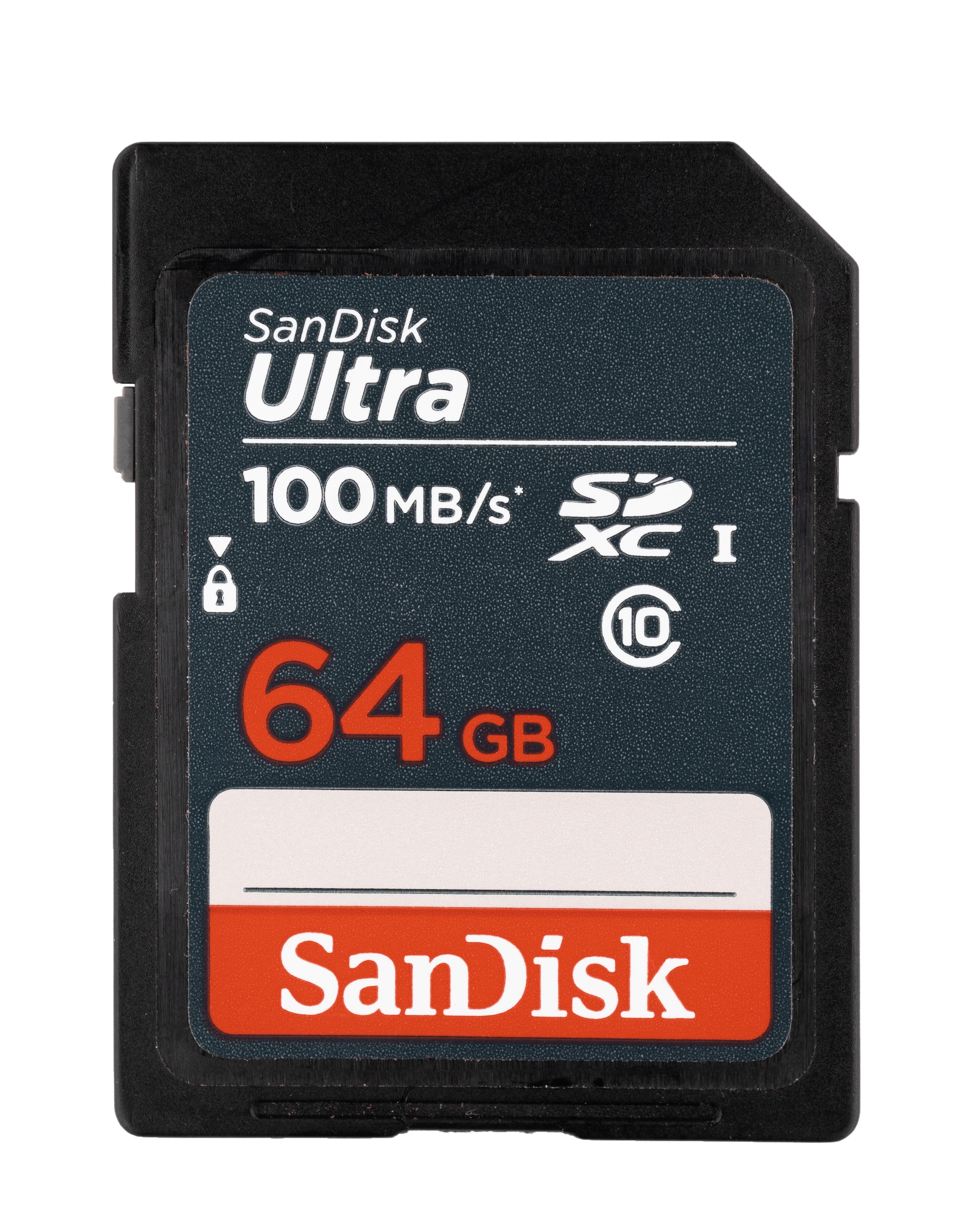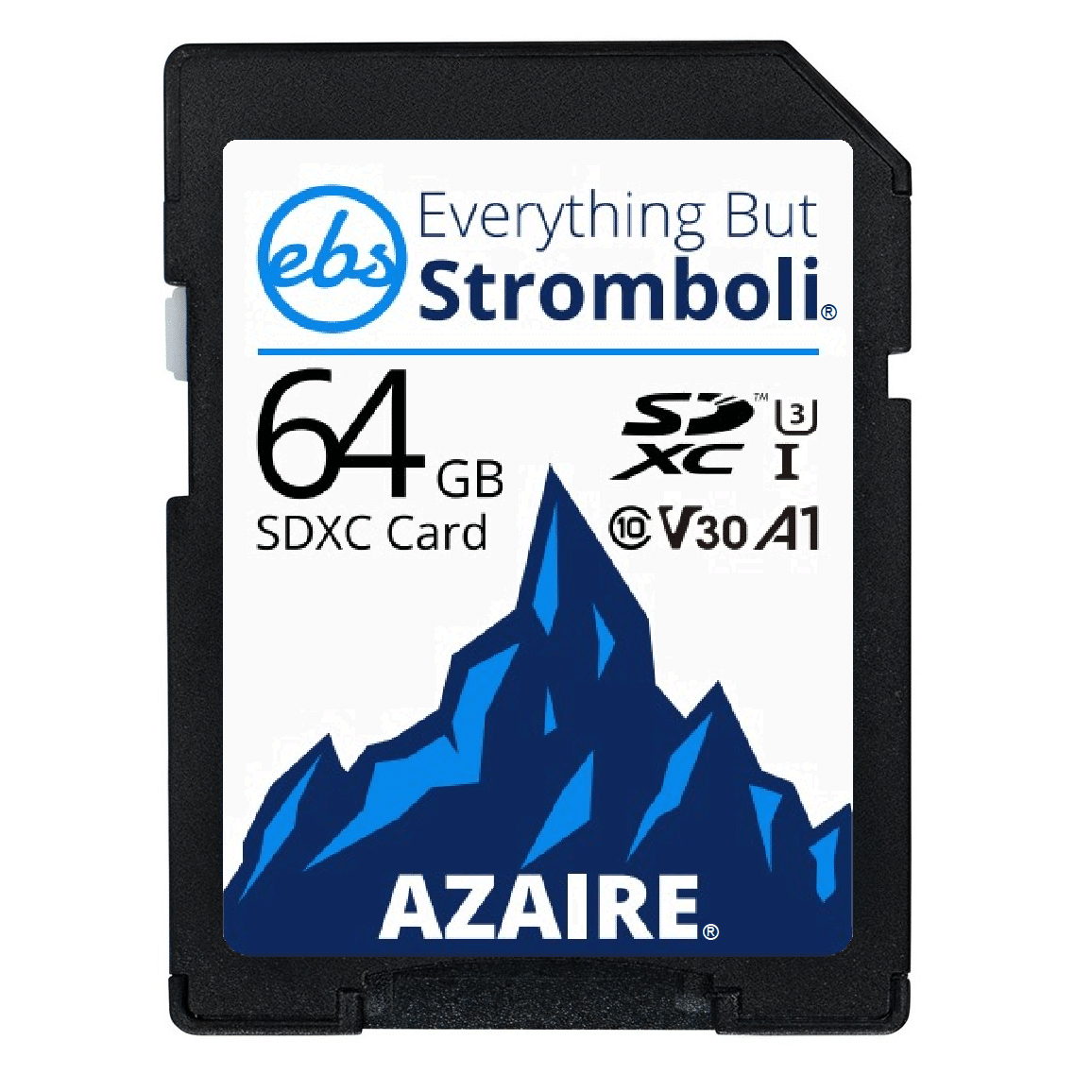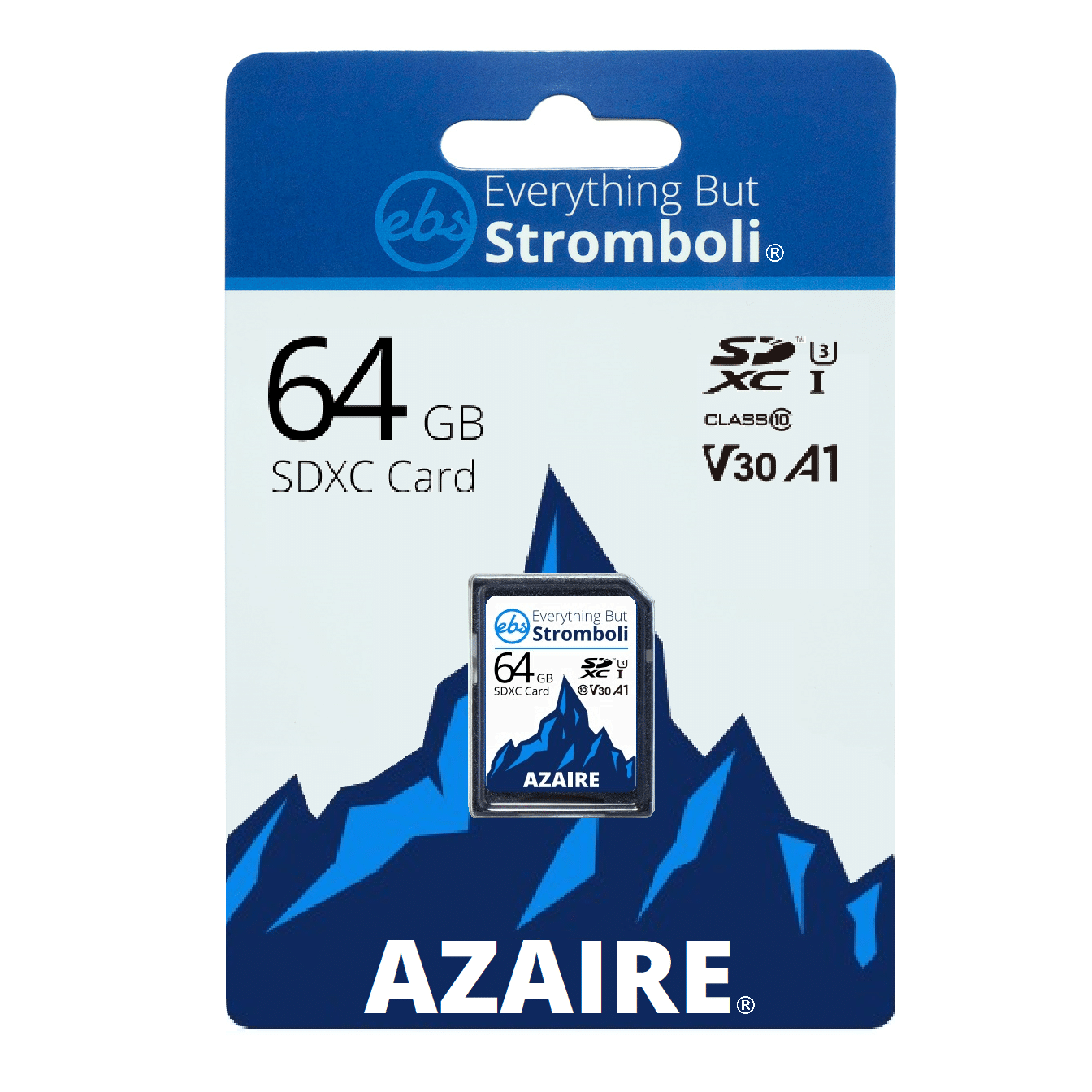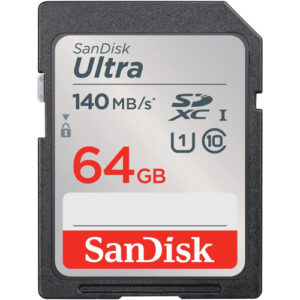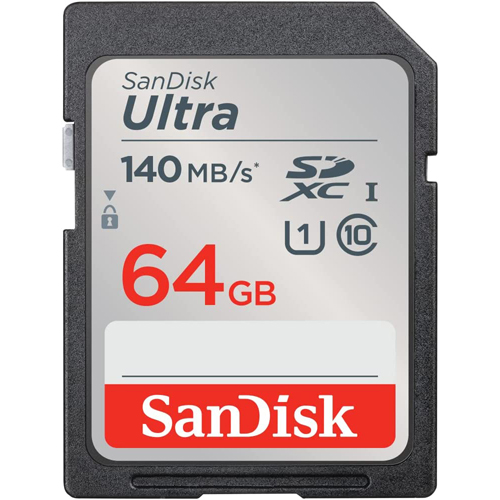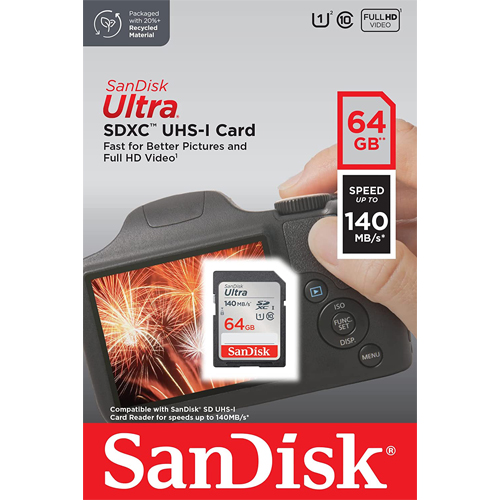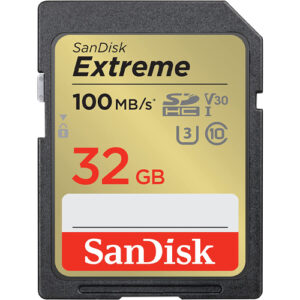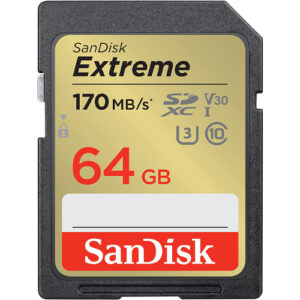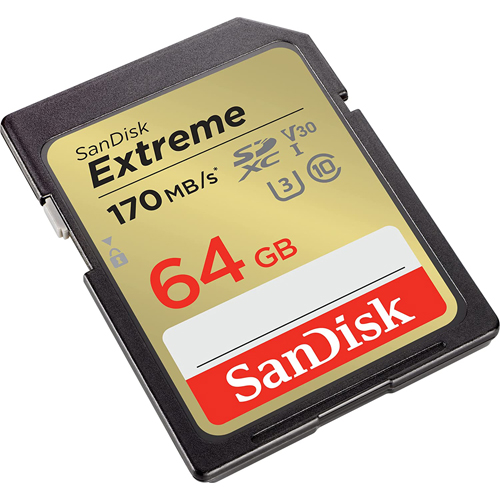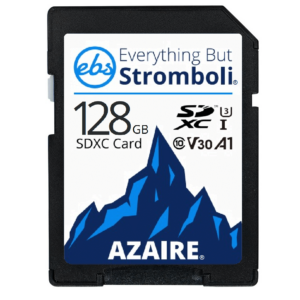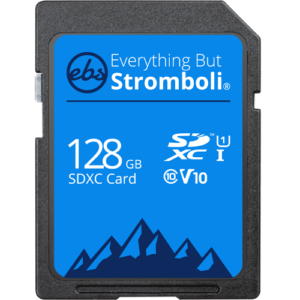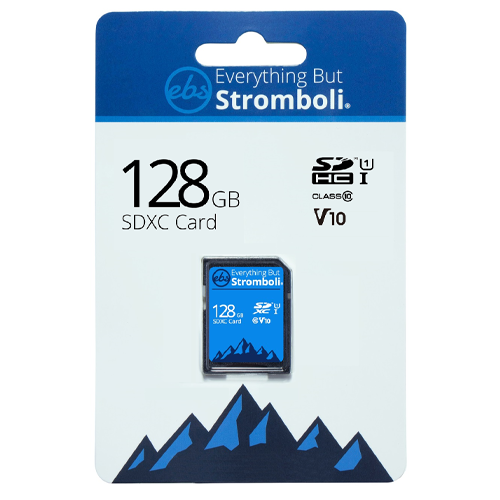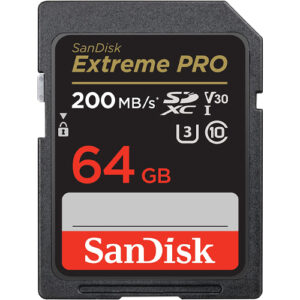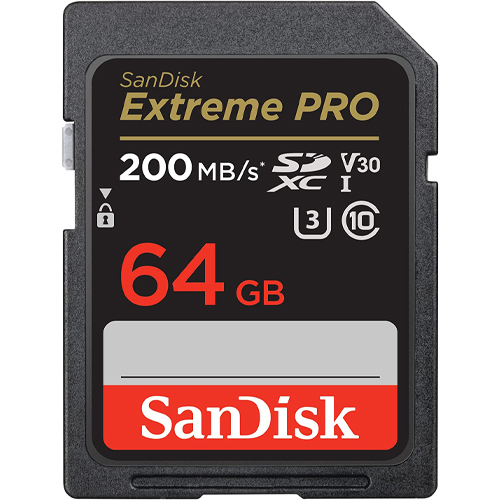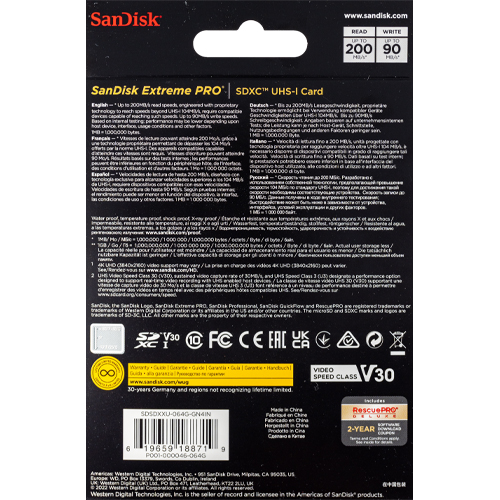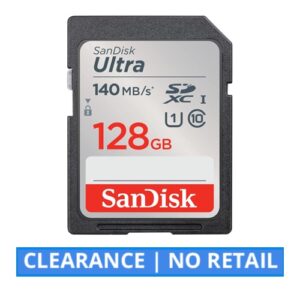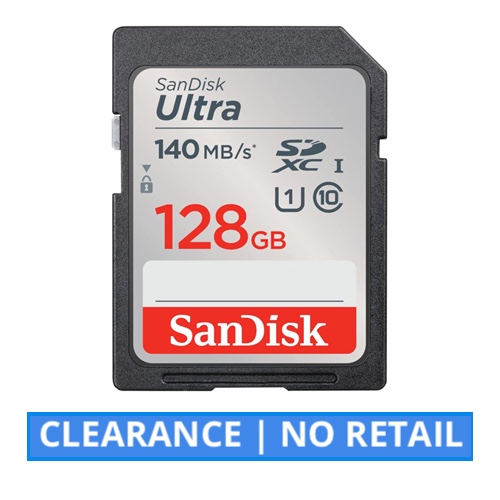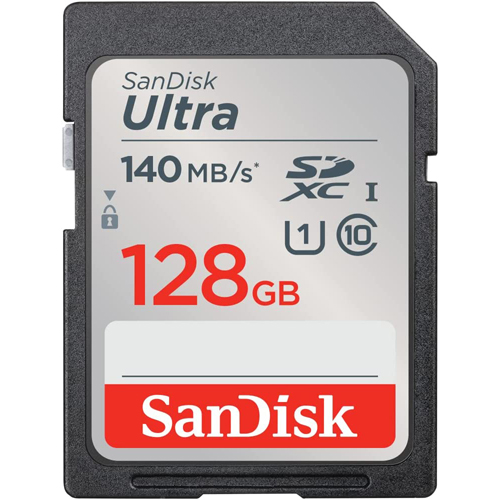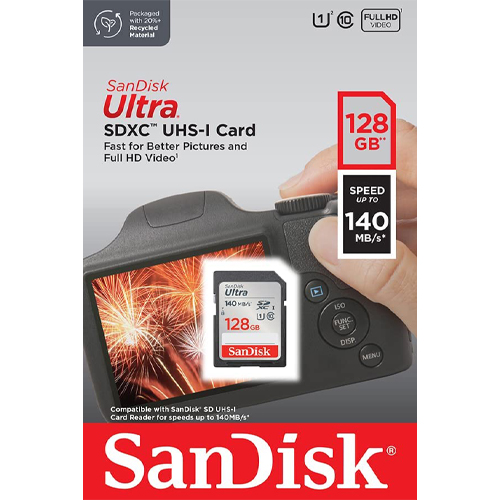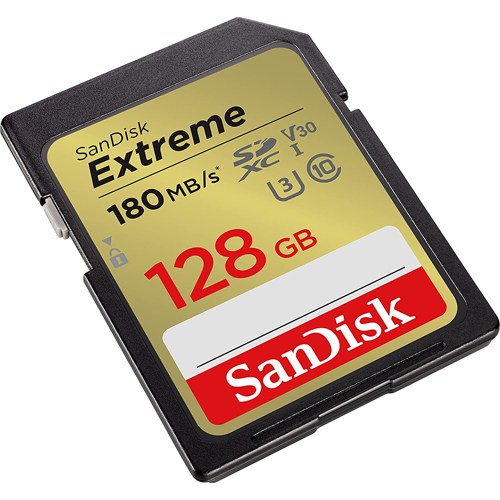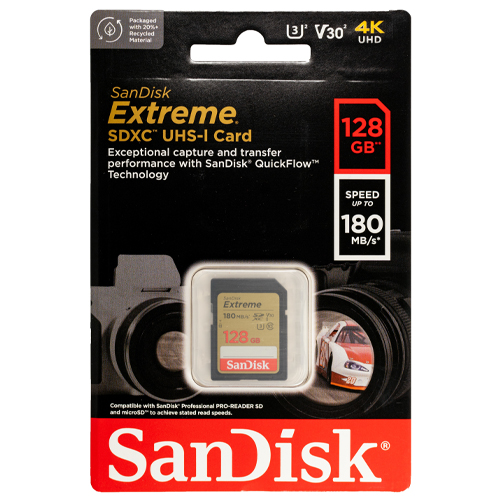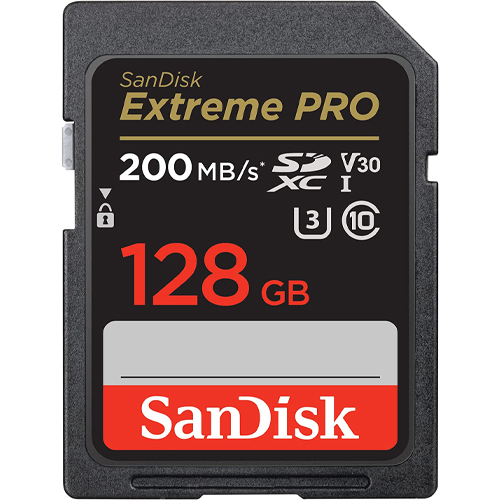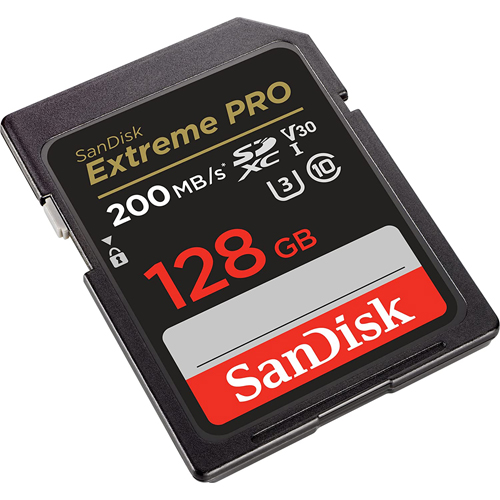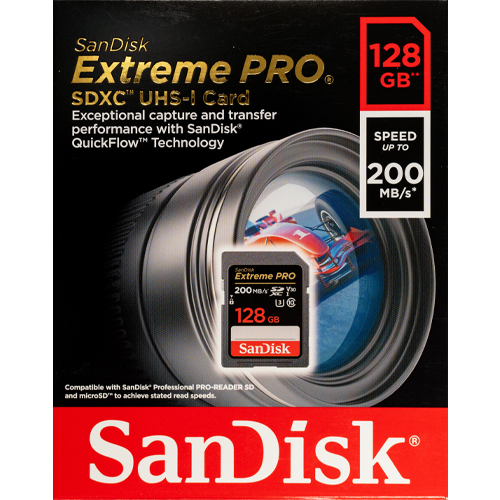SD Cards
If you’re in the market for purchasing SD cards, take a moment to explore your options to ensure you make the most of your investment. Consider the following questions to guide your decision:
- Will you be using the SD cards for internal or external storage?
- Do you have specific requirements in terms of class or storage size that align with your needs?
- Are you interested in a particular brand?
By addressing these questions, you can easily determine the most suitable SD cards for your intended purposes.
Showing 1–30 of 52 resultsSorted by price: low to high
-

8GB (1)
-

16GB (5)
-

32GB (7)
-

64GB (11)
-

128GB SD (11)
-

256GB SD Cards (9)
-

512GB (6)
-

1TB (2)
-

All SD Class 4 Cards (2)
-

All SD Class 10 Cards (50)
-

All SD UHS-II Cards (6)
-
8GB Class 10
8GB SDHC Class 10 Everything But Stromboli U1/V10 Memory Card (8GB SD EBS-8SD-U1)
Everything But Stromboli 8GB SDHC Class 10 Card. This card is a fast, durable SDHC card that is great for photographers, IT professionals, trail cameras, and more! Will hold over 2,000 photos when using a 10 mega-pixel camera, or 100 minutes of video when recording at 9mbps.
Specifications
- Model Number: EBS-8SD-U1
- Class: 10
- Form Factor: SDHC
- UHS BUS Speed: UHS-I
- UHS Speed Class: U1
- Video Speed Class: V10
**This product comes in original retail packaging ready for resale. EBS return policy linked here.
Model # EBS-8SD-U1
(0 reviews)From: $4.85
(Pricing as low as $4.00) Select options This product has multiple variants. The options may be chosen on the product page -
SD Cards
16GB SDHC Class 10 Everything But Stromboli U1/V10 Memory Card (16GB SD EBS-16SD-U1)
Everything But Stromboli 16GB SDHC Class 10 Card. This card is a fast, durable SDHC card that is great for photographers, IT professionals, trail cameras, video recording and more!
Specifications
- Model Number: EBS-16SD-U1
- Class: 10
- Form Factor: SDHC
- UHS BUS Speed: UHS-I
- UHS Speed Class: U1
- Video Speed Class: V10
Estimated Number of Photos & Videos
JPG Photos: 4,310 photos
RAW Photos: 295 photos
HD Video: 210 minutes
4k Video: 40 minutes**This product comes in original retail packaging ready for resale. EBS return policy linked here.
Model # EBS-16SD-U1
(0 reviews)From: $5.00
(Pricing as low as $4.15) Select options This product has multiple variants. The options may be chosen on the product page -
SD Cards
16GB SD Sandisk Memory Card (SDSDB-016G-B35)
High Quality 16GB SD SanDisk Card. This card is ideal for picture and video packages.
Specifications
- Model Number: SDSDB-016G-B35
- Class: 4
- Form Factor: SDHC
- UHS BUS Speed: UHS-I
- Operating Temperature: -13° – 185° F (-25°C – 85° C)
Estimated Number of Photos & Videos
JPG Photos: 4,310 photos
RAW Photos: 295 photos
HD Video: 210 minutes
4k Video: 40 minutes**This product comes in original retail packaging ready for resale. EBS return policy linked here.
Model # SDSDB-016G-B35
(10 reviews)From: $5.15
(Pricing as low as $4.15) Select options This product has multiple variants. The options may be chosen on the product page -
SD Cards
32GB SDHC Class 10 Everything But Stromboli U1/V10 Memory Card (32GB SD EBS-32SD-U1)
Everything But Stromboli 32GB SDHC Class 10 Card. This card is a fast, durable SDHC card that is great for photographers, IT professionals, trail cameras, video recording and more!
Specifications
- Model Number: EBS-32SD-U1
- Class: 10
- Form Factor: SDHC
- UHS BUS Speed: UHS-I
- UHS Speed Class: U1
- Video Speed Class: V10
Estimated Number of Photos & Videos
JPG Photos: 8,620 photos
RAW Photos: 595 photos
HD Video: 425 minutes
4k Video: 85 minutes**This product comes in original retail packaging ready for resale. EBS return policy linked here.
Model # EBS-32SD-U1
(0 reviews)From: $5.30
(Pricing as low as $4.45) Select options This product has multiple variants. The options may be chosen on the product page -
SD Cards
16GB SDHC Ultra Sandisk Memory Card Class 10 (SDSDUNS-016G-GN3IN)
High Quality 16GB SD Ultra SanDisk Class 10 Memory Card. This card is ideal for picture and video packages.
Specifications
- Model Number: SDSDUNS-016G-GN3IN
- Class: 10
- Form Factor: SDHC
- UHS BUS Speed: UHS-I
- Read Speed: Max 80MB/s
- UHS Speed Class: U1
- Video Format Capability: Full HD Video
- Operating Temperature: -13° – 185° F (-25°C – 85° C)
Water-proof, Temperature proof, X-ray proof, Shock proof
Estimated Number of Photos & Videos
JPG Photos: 4,310 photos
RAW Photos: 295 photos
HD Video: 210 minutes
4k Video: 40 minutes**This product comes in original retail packaging ready for resale. EBS return policy linked here.
Model # SDSDUNS-016G-GN3IN
(6 reviews)From: $5.45
(Pricing as low as $4.45) Select options This product has multiple variants. The options may be chosen on the product page -
SD Cards
16GB SD Ultra Sandisk Memory Card (SDSDUNC-016G-GN6IN)
Great card for new point and shoot cameras, DSLR, and professional cameras.
Specifications
- Model Number: SDSDUNC-016G-GN6IN
- Class: 10
- Form Factor: SDHC
- UHS BUS Speed: UHS-I
- Read Speed: Max 80MB/s
- UHS Speed Class: U1
- Video Format Capability: Full HD Video
- Operating Temperature: -13° – 185° F (-25°C – 85° C)
Water-proof, Temperature proof, X-ray proof, Shock proof
Estimated Number of Photos & Videos
JPG Photos: 4,310 photos
RAW Photos: 295 photos
HD Video: 210 minutes
4k Video: 40 minutes**This product comes in original retail packaging ready for resale. EBS return policy linked here.
Model # SDSDUNC-016G-GN6IN
(8 reviews)From: $5.60
(Pricing as low as $4.60) Select options This product has multiple variants. The options may be chosen on the product page -
SD Cards
32GB SD Sandisk Memory Card (SDSDB-032G-B35)
High Quality 32GB SD SanDisk Class 4 Memory Card. This card is ideal for picture and video packages.
Specifications
- Model Number: SDSDB-032G-B35
- Class: 4
- Form Factor: SDHC
- UHS BUS Speed: UHS-I
- UHS Speed Class: U1
- Video Speed Class: V10
- Operating Temperature: -13° – 185° F (-25°C – 85° C)
Estimated Number of Photos & Videos
JPG Photos: 8,620 photos
RAW Photos: 595 photos
HD Video: 425 minutes
4k Video: 85 minutes**This product comes in original retail packaging ready for resale. EBS return policy linked here.
Model # SDSDB-032G-B35
(4 reviews)From: $5.75
(Pricing as low as $4.75) Select options This product has multiple variants. The options may be chosen on the product page -
SD Cards
32GB SD Sandisk Ultra Memory Card (SDSDUNR-032G-GN3IN)
The 32GB SD SanDisk Ultra Memory Card is a High Quality Class 10 Memory Card. This card is ideal for picture and video packages.
Specifications
- Model Number: SDSDUNR-032G-GN3IN
- Class: 10
- Form Factor: SDHC
- UHS BUS Speed: UHS-I
- Read Speed: Max 100MB/s
- UHS Speed Class: U1
- Video Format Capability: Full HD Video
- Operating Temperature: -13° – 185° F (-25°C – 85° C)
Water-proof, Temperature proof, X-ray proof, Shock proof
Estimated Number of Photos & Videos
JPG Photos: 8,620 photos
RAW Photos: 595 photos
HD Video: 425 minutes
4k Video: 85 minutes**This product comes in original retail packaging ready for resale. EBS return policy linked here.
Model # SDSDUNR-032G-GN3IN
(3 reviews)From: $5.95
(Pricing as low as $4.95) Select options This product has multiple variants. The options may be chosen on the product page -
SD Cards
32GB SD Ultra Sandisk Memory Card (SDSDUN4-032G-GN6IN)
This card works great with DSLRs, point-and-shoot cameras, compact cameras, other products, and more. The 32GB SanDisk Ultra SDXC is an extended SD storage size with good transfer speeds for photo and video. SanDisk Ultra comes in several sizes ranging from 32GB to 512GB. Perfect for family photos and videos. This SanDisk Ultra card is a great memory card for saving your photos and memories. Exceptional picture quality and video performance. This card is UHS-1 rated with Class 10 specification. Ideal for a wide range of uses in several products.
Specifications
- Model Number: SDSDUN4-032G-GN6IN
- Class: 10
- Form Factor: SDHC
- UHS BUS Speed: UHS-I
- Read Speed: Max 120MB/s
- UHS Speed Class: U1
- Video Format Capability: Full HD Video
- Operating Temperature: -13° – 185° F (-25°C – 85° C)
Water-proof, Temperature proof, X-ray proof, Shock proof
Estimated Number of Photos & Videos
JPG Photos: 8,620 photos
RAW Photos: 595 photos
HD Video: 425 minutes
4k Video: 85 minutes**This product comes in original retail packaging ready for resale. EBS return policy linked here.
Model # SDSDUN4-032G-GN6IN
(3 reviews)From: $6.30
(Pricing as low as $5.45) Select options This product has multiple variants. The options may be chosen on the product page -
Pre-Tariff Pricing
64GB SDXC Class 10 Everything But Stromboli U1/V10 Memory Card (64GB SD EBS-64SD-U1 EOL)
Everything But Stromboli 64GB SDXC Class 10 Card. This card is a fast, durable SDXC card that is great for photographers, IT professionals, video recording and more!
Certified to meet U1 and V10 speeds.
*Comes in retail packaging ready for resale!
(0 reviews)$6.65
(Pricing as low as $5.80) Select options This product has multiple variants. The options may be chosen on the product page -
SD Cards
64GB Kingston Class 10 SDXC Flash Memory Card SDS2/64GB
Kingston Canvas Select 64GB
This Kingston Canvas Select Plus comes in a 64GB storage capacity with a 100MB/s max read speed. The SDXC memory card has a UHS-1 interface. Designed for capturing life on the move. Capture full HD 1080p or UHD 4K video with a certified V10, U1, and Class 10 speed rating. Great for photos and videos on many compatible cameras. This card will work with beginner to professional DSLR cameras and mirrorless cameras. You can pair this 64GB card with compatible Blu-ray players, home theaters, and more to expand the storage and hold thousands of songs and hundreds of movies. Works great with family cameras and point and shoot cameras. Super high quality speeds with a large SDXC capacity. The ideal card for all types of devices that take a full size SD Card like computers and digital cameras. The Canvas Select Plus can be used for expandable storage on laptops or used to put pictures on digital photo frames. Kingston SD cards are tested and designed for durability.
Specifications
- Model Number: SDS2/64GB
- Class: 10
- Form Factor: SDXC
- UHS BUS Speed: UHS-I
- Read Speed: Max 100MB/s
- UHS Speed Class: U1
- Video Speed Class: V10
- Video Format Capability: 4K UHD, Full HD
- Operating Temperature: -13° – 185° F (-25°C – 85° C)
Water-proof, Temperature proof, X-ray proof, Shock proof, Vibration Proof
Estimated Number of Photos & Videos
JPG Photos: 17,245 photos
RAW Photos: 1,190 photos
HD Video: 850 minutes
4k Video: 170 minutes**This product comes in original retail packaging ready for resale. EBS return policy linked here.
Model # SDS2/64GB
(0 reviews)From: $7.05
(Pricing as low as $6.05) Select options This product has multiple variants. The options may be chosen on the product page -
SD Cards
16GB SD Extreme Sandisk Memory Card (SDSDXNE-016G-GNCIN)
The 16GB SD Extreme SanDisk card is a great choice for photographers and professionals looking for higher transfer speeds and higher quality images.
Specifications
- Model Number: SDSDXNE-016G-GNCIN
- Class: 10
- Format: SDHC
- UHS BUS Speed: UHS-I
- Read Speed: Max 90MB/s
- Write Speed: Max 40MB/s
- UHS Speed Class: U3
- Video Speed Class: V30
- Video Format Capability: 4K UHD
- Operating Temperature: -13° – 185° F (-25°C – 85° C)
Water-proof, Temperature proof, X-ray proof, Shock proof
Estimated Number of Photos & Videos
JPG Photos: 4,310 photos
RAW Photos: 295 photos
HD Video: 210 minutes
4k Video: 40 minutes**This product comes in original retail packaging ready for resale. EBS return policy linked here.
Model # SDSDXNE-016G-GNCIN
(0 reviews)From: $7.15
(Pricing as low as $6.15) Select options This product has multiple variants. The options may be chosen on the product page -
SD Cards
64GB SDXC Class 4 Sandisk Memory Card (SDSDB-064G-B35)
The SanDisk 64GB SD Class 4 card is an economical choice for basic photography and video. Great for trail cameras and digital cameras that accept SDXC.
Specifications
- Model Number: SDSDB-064G-B35
- Class: 4
- Form Factor: SDHC
- UHS BUS Speed: UHS-I
- UHS Speed Class: U1
- Video Speed Class: V10
- Operating Temperature: -13° – 185° F (-25°C – 85° C)
Estimated Number of Photos & Videos
JPG Photos: 17,245 photos
RAW Photos: 1,190 photos
HD Video: 850 minutes
4k Video: 170 minutes**This product comes in original retail packaging ready for resale. EBS return policy linked here.
Model # SDSDB-064G-B35
(0 reviews)From: $7.20
(Pricing as low as $6.35) Select options This product has multiple variants. The options may be chosen on the product page -
SD Cards
64GB SDXC Ultra Sandisk Memory Card Class 10 (SDSDUNR-064G-GN3IN)
High Quality 64GB SD Ultra SanDisk Class 10 Memory Card. This is a great economical choice for 64GB of storage for trail cameras, DSLR Cameras, Point-and-shoot, and more.
Specifications
- Model Number: SDSDUNR-064G-GN3IN
- Class: 10
- Form Factor: SDXC
- UHS BUS Speed: UHS-I
- Read Speed: Max 100MB/s
- UHS Speed Class: U1
- Video Format Capability: Full HD Video
- Operating Temperature: -13° – 185° F (-25°C – 85° C)
Water-proof, Temperature proof, X-ray proof, Shock proof
Estimated Number of Photos & Videos
JPG Photos: 17,245 photos
RAW Photos: 1,190 photos
HD Video: 850 minutes
4k Video: 170 minutes**This product comes in original retail packaging ready for resale. EBS return policy linked here.
Model # SDSDUNR-064G-GN3IN
(0 reviews)From: $7.35
(Pricing as low as $6.35) Select options This product has multiple variants. The options may be chosen on the product page -
SD Cards
64GB Azaire SDXC Class 10 Everything But Stromboli U3/V30 Memory Card (64GB SD Azaire EBS-64SD-U3 EOL)
Everything But Stromboli Azaire 64GB SDXC Class 10 Card. This card is a fast, durable SDXC card that is great for photographers, IT professionals, video recording and more!
Certified to meet fast U3 and V30 speeds!
*Comes in retail packaging ready for resale!
(0 reviews)From: $7.65
(Pricing as low as $6.65) Select options This product has multiple variants. The options may be chosen on the product page -
SD Cards
64GB SDXC Ultra Sandisk Memory Card (SDSDUNB-064G-GN6IN)
The 64GB SanDisk Ultra UNB comes in several sizes ranging from 32GB to 512GB. The 64GB SanDisk Ultra SDXC is an extended SD storage size with good transfer speeds for photo and video. This card works great with DSLRs, point-and-shoot cameras, compact cameras, other products, and more. Perfect for family photos and videos. This card is UHS-1 rated with Class 10 specification. Ideal for a wide range of uses in several products. This SanDisk Ultra card is a great memory card for almost anything. Exceptional picture quality and video performance. 64GB SanDisk Ultra UNB.
Specifications
- Model Number: SDSDUNB-064G-GN6IN
- Class: 10
- Form Factor: SDXC
- UHS BUS Speed: UHS-I
- Read Speed: Max 140MB/s
- UHS Speed Class: U1
- Video Format Capability: Full HD Video
- Operating Temperature: -13° – 185° F (-25°C – 85° C)
Water-proof, Temperature proof, X-ray proof, Shock proof
Estimated Number of Photos & Videos
JPG Photos: 17,245 photos
RAW Photos: 1,190 photos
HD Video: 850 minutes
4k Video: 170 minutes**This product comes in original retail packaging ready for resale. EBS return policy linked here.
Model # SDSDUNB-064G-GN6IN(0 reviews)From: $7.85
(Pricing as low as $7.00) Select options This product has multiple variants. The options may be chosen on the product page -
SD Cards
32GB SD Extreme Sandisk Memory Card (SDSDXVT-032G-GNCIN)
This new Extreme SD Card from SanDisk has a 32GB capacity. This updated version has a 100MB/s maximum read speed. That’s more than 11% faster! Some features of this card are that it is waterproof, temperature proof, shock proof, and X-ray proof. The 32GB SD Extreme SanDisk card is a great choice for photographers and professionals looking for higher transfer speeds and higher quality images. Perfect for beginner to professional DSLR cameras and mirrorless cameras. You can pair this 32GB card with compatible Blu-ray players, home theaters, and more to expand the storage and hold thousands of songs and hundreds of movies. Works great with family cameras and point and shoot cameras. Super high quality speeds with a large SDHC capacity. This card is rated for U3 and Class 10 speeds. The ideal card for all types of devices that take a full size SD Card like computers and digital cameras. The Extreme Pro SD card can be used for expandable storage on laptops or used to put pictures on digital photo frames. SanDisk Extreme 32GB XVT.
Specifications
- Model Number: SDSDXVT-032G-GNCIN
- Class: 10
- Format: SDHC
- UHS BUS Speed: UHS-I
- Read Speed: Max 100MB/s
- Write Speed: Max 60MB/s
- UHS Speed Class: U3
- Video Speed Class: V30
- Video Format Capability: 4K UHD
- Operating Temperature: -13° – 185° F (-25°C – 85° C)
Water-proof, Temperature proof, X-ray proof, Shock proof
Estimated Number of Photos & Videos
JPG Photos: 8,620 photos
RAW Photos: 595 photos
HD Video: 425 minutes
4k Video: 85 minutes**This product comes in original retail packaging ready for resale. EBS return policy linked here.
Model # SDSDXVT-032G-GNCIN
(0 reviews)From: $8.15
(Pricing as low as $7.15) Select options This product has multiple variants. The options may be chosen on the product page -
SD Cards
64GB SD Extreme Sandisk Memory Card (SDSDXV2-064G-GNCIN)
This new Extreme SD Card from SanDisk has a 64GB capacity. Super high quality speeds with a large SDXC capacity. This updated version has a 170MB/s maximum read speed. That’s more than 13% faster! Some features of this card are that it is waterproof, temperature proof, shock proof, and X-ray proof. The ideal card for all types of devices that take a full size SD Card like computers and digital cameras. The 64GB SD Extreme SanDisk card is a great choice for photographers and professionals looking for higher transfer speeds and higher quality images. Perfect for beginner to professional DSLR cameras and mirrorless cameras. You can pair this 64GB card with compatible Blu-ray players, home theaters, and more to expand the storage and hold thousands of songs and hundreds of movies. Works great with family cameras and point and shoot cameras. This card is rated for U3 and Class 10 speeds. The Extreme Pro SD card can be used for expandable storage on laptops or used to put pictures on digital photo frames. SanDisk Extreme 64GB XV2.
Specifications
- Model Number: SDSDXV2-064G-GNCIN
- Class: 10
- Format: SDXC
- UHS BUS Speed: UHS-I
- Read Speed: Max 170MB/s
- Write Speed: Max 80MB/s
- UHS Speed Class: U3
- Video Speed Class: V30
- Video Format Capability: 4K UHD
- Operating Temperature: -13° – 185° F (-25°C – 85° C)
Water-proof, Temperature proof, X-ray proof, Shock proof
Estimated Number of Photos & Videos
JPG Photos: 17,245 photos
RAW Photos: 1,190 photos
HD Video: 850 minutes
4k Video: 170 minutes**This product comes in original retail packaging ready for resale. EBS return policy linked here.
Model # SDSDXV2-064G-GNCIN
(0 reviews)From: $9.65
(Pricing as low as $8.65) Select options This product has multiple variants. The options may be chosen on the product page -
Pre-Tariff Pricing
128GB Azaire SDXC Class 10 Everything But Stromboli U3/V30 Memory Card (128GB SD Azaire EBS-128SD-U3 EOL)
Everything But Stromboli Azaire 128GB SDXC Class 10 Card. This card is a fast, durable SDXC card that is great for photographers, IT professionals, video recording and more!
Certified to meet fast U3 and V30 speeds!
*Comes in retail packaging ready for resale!
(0 reviews)From: $10.00
(Pricing as low as $9.00) Select options This product has multiple variants. The options may be chosen on the product page -
SD Cards
32GB SD Extreme Pro SDHC UHS-I Sandisk Memory Card (SDSDXXO-032G-GN4IN)
The new Extreme Pro SD Card from SanDisk has a 32GB capacity. This updated version has a 100MB/s maximum read speed. That’s more than 5% faster! Some features of this card are that it is waterproof, temperature proof, shock proof, and X-ray proof. Perfect for beginner to professional DSLR cameras and mirrorless cameras. Works great with family cameras and point and shoot cameras. Super high quality speeds with a large SDHC capacity. This card is rated for U3 and Class 10 speeds. The ideal card for all types of devices that take a full size SD Card like computers and digital cameras. The Extreme Pro SD card can be used for expandable storage on laptops or used to put pictures on digital photo frames. You can pair this 32GB card with compatible Blu-ray players, home theaters, and more to expand the storage and hold thousands of songs and hundreds of movies. Extreme Pro 32GB XXO.
Specifications
- Model Number: SDSDXXO-032G-GN4IN
- Class: 10
- Format: SDHC
- UHS BUS Speed: UHS-I
- Read Speed: Max 100MB/s
- Write Speed: Max 90MB/s
- UHS Speed Class: U3
- Video Speed Class: V30
- Video Format Capability: 4K UHD
- Operating Temperature: -13° – 185° F (-25°C – 85° C)
Water-proof, Temperature proof, X-ray proof, Shock proof
Estimated Number of Photos & Videos
JPG Photos: 8,620 photos
RAW Photos: 595 photos
HD Video: 425 minutes
4k Video: 85 minutes**This product comes in original retail packaging ready for resale. EBS return policy linked here.
Model # SDSDXXO-032G-GN4IN
(0 reviews)From: $10.10
(Pricing as low as $9.25) Select options This product has multiple variants. The options may be chosen on the product page -
Pre-Tariff Pricing
128GB SDXC Class 10 Everything But Stromboli U1/V10 Memory Card (128GB SD EBS-128SD-U1 EOL)
Everything But Stromboli 128GB SDXC Class 10 Card. This card is a fast, durable SDXC card that is great for photographers, IT professionals, video recording and more!
Certified to meet U1 and V10 speeds.
*Comes in retail packaging ready for resale!
(0 reviews)From: $10.90
(Pricing as low as $9.90) Select options This product has multiple variants. The options may be chosen on the product page -
SD Cards
128GB SD Ultra Sandisk Memory Card (SDSDUNR-128G-GN3IN)
128GB SanDisk Ultra Blue Memory Cards, your ultimate companion for capturing unforgettable moments with trail cameras, hunting cams, shoot-and-point digital cameras, and mid-range DSLRs.
Experience lightning-fast data transfer with these SD Memory Cards, boasting impressive speeds of up to 100MB/s – that’s twice as fast compared to Class 4 SanDisk Ultra cards. With this incredible speed, you can effortlessly snap pictures and transfer files in the blink of an eye.
Don’t miss a single detail during your video recordings with the Class 10 rating and UHS-I speeds. Enjoy exceptional Full HD video (1080p) performance, ensuring your footage remains crystal-clear and professional.
SanDisk cards are designed to withstand the toughest conditions, ensuring your precious memories stay safe. They are shockproof, temperature-proof, waterproof, and even X-ray-proof. So, whether you’re in extreme environments or unpredictable situations, rest assured that your data is protected.
Upgrade your photography and videography game with the reliable and durable 128GB SanDisk Ultra Blue Memory Cards – the perfect choice for every adventure and project.
Specifications
- Model Number: SDSDUNR-128G-GN3IN
- Class: 10
- Form Factor: SDXC
- UHS BUS Speed: UHS-I
- Read Speed: Max 100MB/s
- UHS Speed Class: U1
- Video Format Capability: Full HD Video
- Operating Temperature: -13° – 185° F (-25°C – 85° C)
Water-proof, Temperature proof, X-ray proof, Shock proof
Estimated Number of Photos & Videos
JPG Photos: 34,490 photos
RAW Photos: 2,380 photos
HD Video: 1,705 minutes
4k Video: 340 minutes**This product comes in original retail packaging ready for resale. EBS return policy linked here.
Model # SDSDUNR-128G-GN3IN
(0 reviews)From: $11.25
(Pricing as low as $10.25) Select options This product has multiple variants. The options may be chosen on the product page -
SD Cards
64GB SD Extreme Pro SDXC UHS-I Sandisk Memory Card (SDSDXXU-064G-GN4IN)
The new Extreme Pro SD Card from SanDisk has a 64GB capacity. This updated version has a 200MB/s maximum read speed. That’s more than 15% faster! Some features of this card are that it is waterproof, temperature proof, shock proof, and X-ray proof. Perfect for beginner to professional DSLR cameras and mirrorless cameras. Works great with family cameras and point and shoot cameras. Super high quality speeds with a large SDXC capacity. This card is rated for U3 and Class 10 speeds. The ideal card for all types of devices that take a full size SD Card like computers and digital cameras. The Extreme Pro SD card can be used for expandable storage on laptops or used to put pictures on digital photo frames. You can pair this 64GB card with compatible Blu-ray players, home theaters, and more to expand the storage and hold thousands of songs and hundreds of movies. Extreme Pro 64GB XXU.
Specifications
- Model Number: SDSDXXU-064G-GN4IN
- Class: 10
- Format: SDXC
- UHS BUS Speed: UHS-I
- Read Speed: Max 200MB/s
- Write Speed: Max 90MB/s
- UHS Speed Class: U3
- Video Speed Class: V30
- Video Format Capability: 4K UHD
- Operating Temperature: -13° – 185° F (-25°C – 85° C)
Water-proof, Temperature proof, X-ray proof, Shock proof
Estimated Number of Photos & Videos
JPG Photos: 17,245 photos
RAW Photos: 1,190 photos
HD Video: 850 minutes
4k Video: 170 minutes**This product comes in original retail packaging ready for resale. EBS return policy linked here.
Model # SDSDXXU-064G-GN4IN
(0 reviews)From: $11.55
(Pricing as low as $10.70) Select options This product has multiple variants. The options may be chosen on the product page -
SD Cards
128GB SD Ultra Sandisk Memory Card (SDSDUNB-128G-GN6IN) BULK IN CASES ONLY
The 128GB SanDisk Ultra UNB comes in several sizes ranging from 32GB to 512GB. The 128GB SanDisk Ultra SDXC is an extended SD storage size with good transfer speeds for photo and video. This card works great with DSLRs, point-and-shoot cameras, compact cameras, other products, and more. Perfect for family photos and videos. This card is UHS-1 rated with Class 10 specification. Ideal for a wide range of uses in several products. This SanDisk Ultra card is a great memory card for almost anything. Exceptional picture quality and video performance. 128GB SanDisk Ultra UNB.
Specifications:
- Class 10, U1, UHS-1 Rated – Minimum 10MB/s | Maximum 140MB/s
- Holds an estimated 34,490 JPG Photos or 2,380 RAW photos
- Roughly 1,705 minutes of HD video or 340 minutes of 4k video
**This product comes new out of package in Plastic Cases. EBS return policy linked here. SanDisk Warranty linked here.
Model # (SDSDUNB-128G-GN6IN)
(0 reviews) -
SD Cards
128GB SD Ultra Sandisk Memory Card (SDSDUNB-128G-GN6IN)
The 128GB SanDisk Ultra UNB comes in several sizes ranging from 32GB to 512GB. The 128GB SanDisk Ultra SDXC is an extended SD storage size with good transfer speeds for photo and video. This card works great with DSLRs, point-and-shoot cameras, compact cameras, other products, and more. Perfect for family photos and videos. This card is UHS-1 rated with Class 10 specification. Ideal for a wide range of uses in several products. This SanDisk Ultra card is a great memory card for almost anything. Exceptional picture quality and video performance. 128GB SanDisk Ultra UNB.
Specifications
- Model Number: SDSDUNB-128G-GN6IN
- Class: 10
- Format: SDXC
- Read Speed: Max 140MB/s
- UHS Speed Class: U1
- Video Format Capability: Full HD Video
- Operating Temperature: -13° – 185° F (-25°C – 85° C)
Water-proof, Temperature proof, X-ray proof, Shock proof
Estimated Number of Photos & Videos
JPG Photos: 34,490 photos
RAW Photos: 2,380 photos
HD Video: 1,705 minutes
4k Video: 340 minutes**This product comes in original retail packaging ready for resale. EBS return policy linked here.
Model # SDSDUNB-128G-GN6IN
(0 reviews)From: $12.40
(Pricing as low as $11.40) Select options This product has multiple variants. The options may be chosen on the product page -
SD Cards
128GB Kingston Canvas Go! Plus SD Card SDG3/128GB
Kingston Canvas Go Plus 128GB SD Card
The Kingston Canvas Go Plus 128GB SD Card comes in models with 128GB-512GB storage capacity with a 170MB/s max read speed. This Kingston Canvas Go! Plus is the 128GB version. This is an SDXC memory card and has a UHS-1 interface. Designed for capturing life on the move. Capture up to UHD 4K video with a certified V30, U3, and Class 10 speed rating. Faster than the Canvas Select Plus, the Kingston Canvas Go! Plus 128GB SD Card works best for professionals or devices that need faster read/write speed. This card will work with beginner to professional DSLR cameras and mirrorless cameras. Works great with family cameras and point and shoot cameras. You can pair this 128GB card with compatible Blu-ray players, home theaters, and more to expand the storage and hold thousands of songs and hundreds of movies. The ideal card for all types of devices that take a full size SD Card like computers and digital cameras. The Canvas Go! Plus can be used for expandable storage on laptops or used to put pictures on digital photo frames. Kingston SD cards are tested and designed for durability.
Specifications
- Model Number: SDG3/128GB
- Class: 10
- Form Factor: SDXC
- UHS BUS Speed: UHS-I
- Read Speed: Max 170MB/s
- Write Speed: Max 90MB/s
- UHS Speed Class: U3
- Video Speed Class: V30
- Video Format Capability: 4K UHD
- Operating Temperature: -13° – 185° F (-25°C – 85° C)
Water-proof, Temperature proof, X-ray proof, Shock proof, Vibration Proof
Estimated Number of Photos & Videos
JPG Photos: 34,490 photos
RAW Photos: 2,380 photos
HD Video: 1,705 minutes
4k Video: 340 minutes**This product comes in original retail packaging ready for resale. EBS return policy linked here.
Model # SDG3/128GB
(0 reviews)From: $14.55
(Pricing as low as $13.55) Select options This product has multiple variants. The options may be chosen on the product page -
SD Cards
128GB SD Extreme Sandisk Memory Card (SDSDXVA-128G-GNCIN)
This new Extreme SD Card from SanDisk has a 128GB capacity. This updated version has a 180MB/s maximum read speed. That’s 20% faster! This card is rated for V30, U3, and Class 10 speeds. Some features of this card are that it is waterproof, temperature proof, shock proof, and X-ray proof. The 128GB SD Extreme SanDisk card is a great choice for photographers and professionals looking for higher transfer speeds and higher quality images. Perfect for beginner to professional DSLR cameras and mirrorless cameras. You can pair this 128GB card with compatible Blu-ray players, home theaters, and more to expand the storage and hold thousands of songs and hundreds of movies. Works great with family cameras and point and shoot cameras. Super high quality speeds with a large SDXC capacity. The ideal card for all types of devices that take a full size SD Card like computers and digital cameras. The Extreme SD card can be used for expandable storage on laptops or used to put pictures on digital photo frames. SanDisk Extreme 128GB XVA.
Specifications
- Model Number: SDSDXVA-128G-GNCIN
- Class: 10
- Format: SDXC
- UHS BUS Speed: UHS-I
- Read Speed: Max 180MB/s
- Write Speed: Max 90MB/s
- UHS Speed Class: U3
- Video Speed Class: V30
- Video Format Capability: 4K UHD
- Operating Temperature: -13° – 185° F (-25°C – 85° C)
Water-proof, Temperature proof, X-ray proof, Shock proof
Estimated Number of Photos & Videos
JPG Photos: 34,490 photos
RAW Photos: 2,380 photos
HD Video: 1,705 minutes
4k Video: 340 minutes**This product comes in original retail packaging ready for resale. EBS return policy linked here.
Model # SDSDXVA-128G-GNCIN
(0 reviews)From: $14.75
(Pricing as low as $13.75) Select options This product has multiple variants. The options may be chosen on the product page -
SD Cards
64GB Samsung Pro Ultimate SD Card (MB-SY64S)
64GB Samsung Pro Ultimate SD Card – the perfect solution for creators who demand speed, reliability, and versatility in their storage. With lightning-fast read and write speeds of up to 200 MB/s and 130 MB/s, you can spend more time creating and less time waiting for files to transfer. Whether you’re capturing stunning 4K UHD videos or handling large data-heavy applications, this card’s U3 and V30 ratings ensure top-tier performance, making it an ideal choice for both professionals and hobbyists.Designed for versatility, the 64GB Samsung Pro Ultimate SD Card is compatible with a wide range of devices, from DSLR cameras to PCs, offering seamless performance across various platforms. Whether you’re working on multimedia projects, running demanding applications, or simply saving high-quality files, this card delivers the speed and reliability you need. It’s the perfect companion for any creative or professional setup.
Built to withstand the elements, the PRO Ultimate is engineered with 7-proof protection, keeping your data safe from water, extreme temperatures, and more. With a robust design, you can confidently take your projects wherever inspiration strikes. Plus, the included 10-year limited warranty ensures long-lasting peace of mind, allowing you to focus on your work without worrying about storage reliability.
With a storage capacity of 64GB, this card offers ample space for all your essential files, photos, and videos. Whether you’re a professional videographer, a photographer, or just someone who loves capturing life’s moments, the PRO Ultimate provides the perfect balance of speed, capacity, and protection. Experience the next level of storage with 64GB Samsung Pro Ultimate SD Card, where speed meets reliability.
Specifications:
- Class 10, U3, V30, UHS-1 – Minimum 10MB/s | Maximum 200MB/s
- Holds an estimated 17,245 JPG Photos or 1,190 RAW photos
- Roughly 850 minutes of HD video or 170 minutes of 4k video
**This product comes in original retail packaging ready for resale. EBS return policy linked here. Samsung Warranty linked here.
Model # (MB-SY64S)(0 reviews)From: $15.00
(Pricing as low as $14.00) Select options This product has multiple variants. The options may be chosen on the product page -
SD Cards
128GB SD Extreme Pro SDXC UHS-I Sandisk Memory Card (SDSDXXD-128G-GN4IN)
The new Extreme Pro SD Card from SanDisk has a 128GB capacity. This updated version has a 200MB/s maximum read speed. That’s more than 17% faster! Some features of this card are that it is waterproof, temperature proof, shock proof, and X-ray proof. Perfect for beginner to professional DSLR cameras and mirrorless cameras. Works great with family cameras and point and shoot cameras. Super high quality speeds with a large SDXC capacity. This card is rated for U3 and Class 10 speeds. The ideal card for all types of devices that take a full size SD Card like computers and digital cameras. The Extreme Pro SD card can be used for expandable storage on laptops or used to put pictures on digital photo frames. You can pair this 128GB card with compatible Blu-ray players, home theaters, and more to expand the storage and hold thousands of songs and hundreds of movies. Extreme Pro 128GB XXD.
Specifications
- Model Number: SDSDXXD-128G-GN4IN
- Class: 10
- Format: SDXC
- UHS BUS Speed: UHS-I
- Read Speed: Max 200MB/s
- Write Speed: Max 90MB/s
- UHS Speed Class: U3
- Video Speed Class: V30
- Video Format Capability: 4K UHD
- Operating Temperature: -13° – 185° F (-25°C – 85° C)
Water-proof, Temperature proof, X-ray proof, Shock proof
Estimated Number of Photos & Videos
JPG Photos: 34,490 photos
RAW Photos: 2,380 photos
HD Video: 1,705 minutes
4k Video: 340 minutes**This product comes in original retail packaging ready for resale. EBS return policy linked here.
Model # SDSDXXD-128G-GN4IN
(0 reviews)From: $18.25
(Pricing as low as $17.40) Select options This product has multiple variants. The options may be chosen on the product page -
Pre-Tariff Pricing
256GB Azaire SDXC Class 10 Everything But Stromboli U3/V30 Memory Card (256GB SD Azaire EBS-256SD-U3 EOL)
Everything But Stromboli 256GB SDXC Class 10 Card. This card is a fast, durable SDXC card that is great for photographers, IT professionals, video recording and more!
Certified to meet fast U3 and V30 speeds!
*Comes in retail packaging ready for resale!
(0 reviews)From: $19.20
(Pricing as low as $18.20) Select options This product has multiple variants. The options may be chosen on the product page
Main Considerations When Purchasing Bulk SD Cards
When buying a card for your Nikon DSLR camera or a digital camcorder, you’ll need a faster card compared with merely using an SD card in an MP3 player or digital picture frame, for example. Manufacturers and various tech companies using cards are strict on their requirements in utilizing proper write speeds and supported sizes. Performance is key.
The following guide includes much more information about SD cards to help steer your purchasing decision.
What Is an SD Card?
An SD card, short for secure digital card, is a compact, lightweight and removable flash memory card offering high-capacity storage. While it is one of several types of memory card available, the SD card is among the most popular.
Measuring 1.25 by 0.95 inches and weighing 2 grams, SD cards are used in computers and many electronic devices such as digital video camcorders, digital cameras, digital picture frames, cell phones, game consoles, and MP3 players.
In recent years, a smaller form of SD cards called micro SD cards has emerged to help meet the needs of smaller devices such as cell phones.
A Brief History of SD Cards
SD cards hit the market in 1999 and helped transform storage for electronic devices. As their storage capacities ballooned, these devices became ever more powerful.
SD cards have become capable of storing as many as tens of thousands of images and songs along with hours of HD video on a single card. Users can store numerous program files in a variety of file formats for convenience and security.
What’s the Difference Between SD and Micro SD Memory Cards?
SD cards are available in three sizes: standard, mini, and micro. The standard SD card is the largest.
Micro SD cards have become popular because they are small and fit easily into portable devices such as cell phones. While the connection, port required, and physical size of the cards are different, they both work in devices that accept full-size SD cards.
The micro SD cards offer a lower storage capacity than regular SD cards, but they are available in a wider range of storage capacities than miniSD cards.
SD cards are generally used in devices that have a larger form factor, while micro SD cards are used in smaller devices. Both SD and microSD cards have the same dimensions, but micro SD cards are about one-third the size of an SD card.
Many newer devices, like cell phones and digital cameras, use micro SD cards instead of regular SD cards because they’re smaller. Because of this, mobile phone manufacturers are more likely to place a bulk micro SD card order rather than purchasing smaller amounts or opting for SD cards.
Size Difference between SD Card and Micro SD Card
SD cards are about twice the size of a postage stamp. They’re available in capacities up to 1TB. Micro SD cards are about the size of a fingernail, and are also available in capacities up to 1TB.
Top SD Card Brand Names
Everything But Stromboli carries several top SD card brand names, including Kingston, PNY, and SanDisk. We also carry Lexar cards and our very own branded SD cards.
Everything But Stromboli sells top SD cards individually and at special wholesale prices.
When you purchase Everything But Stromboli SD cards, you’ll save a lot of money compared with buying cards from name-brand competitors while still getting high-quality products.
Uses for SD Cards
SD cards have a wide variety of uses, due to their small size, large storage capacity, and high speed. Some common uses include:
– Storing digital photos, especially in professional cameras
– Storing digital videos
– Playing music
– Running operating systems in portable devices such as netbooks
– Backing up files on computers
– Storing data for GPS devices
– Storing map information on portable devices
– Storing contact information on cell phones
– Playing video games
– Loading software onto portable devices
– Image and video storage for dash cameras
– Collecting and storing footage on a card for a video doorbell or similar surveillance system
– Downloading files from the Internet
Who Uses Bulk SD Cards
Individuals and organizations in a range of industries can benefit from the purchase and use of memory cards in bulk. A professional photographer or videographer might use SD cards in digital video cameras or provide their clients with their own SD cards full of photographs and video footage.
Other professionals who work with AV equipment, mobile phones, computers, and more can also benefit from bulk SD card purchases. Drivers, especially those who cover great distances or need to keep accurate records of their journeys, can also use SD cards in a dash cam to help them track and monitor their travels.
Common Card Sizes
In scoping out SD cards, zoom in on card capacity. Small and large card sizes are available on Everything But Stromboli, carrying capacities up to 1TB. These common SD card sizes meet most people’s needs, although it’s worth noting that the most common sizes are 16GB and 32GB.
If you intend to record lots of HD video and take thousands of RAW or high-megapixel images at a wedding or other event or while on vacation, for example, you’ll benefit from investing in high-capacity cards such as 64 GB, 128 GB, or even 256 GB.
With bulk purchases, although 8GB is a common size, this storage capacity is giving way to higher capacity cards. Cards offering 16 GB and 32 GB of storage capacity are overtaking 4 GB to 8 GB cards in popularity.
Years ago, the larger a card’s internal storage size meant a slower write speed, but this is no longer the case. As write speeds increased from 48 MB to 80 MB per second, larger-capacity cards have soared in popularity.
Class 10 cards write at minimum 10MB/s sustained, making the 64 GB, 128 GB, and 256 GB SD cards more appealing to move files, especially 4K video files, which are very large files. In time, we’ll see terabytes become available on these cards, and we have already seen a video speed class emerge.
SD Card Specs: What Does Each SD Card Terminology Indicate?
The Everything But Stromboli team has produced this handy guide breaking down SD card specs. These cards have a lot of terminologies, making it confusing for consumers to understand what kind of card(s) they need.
– SDHC: Secure Digital High Capacity, which generally covers card sizes between 4 GB and 32 GB.
– SDXC: Secure Digital eXtended Capacity, optimized for full-HD (1920×1080 resolution) recording and is compatible with only SDXC devices, commonly media devices.
– Class or series: The class is the rated classification for a card’s write speed. Class indicates how fast information is uploaded and written onto the device. Cards have been made as Class 2, Class 4, Class 6, and Class 10, with the latter writing at a speed of at least 10 MB per second.
– UHS: Ultra High Speed is another designation of write speed, a drive with a U1 symbol writes at 10 MB per second and a U3 writes at 30 MB per second.
– V: A “V” designation represents a video-oriented card with the video class speed of V6 (6 MB per second), V10 (10 MB per second), V30 (30 MB per second), V60 (
60 MB per second), and V90 (90 MB per second). Video requires a certain write speed to record a given quality of video. The higher the quality, the higher the necessary write speed.
SanDisk, for example, labels its card classes with the names Ultra, Extreme, and Extreme Pro, with each tier operating at higher read speeds than the previous and much faster write speeds. The Ultra is a step up from a standard SD card, and the Extreme variety is better still. The Extreme Pro card performs the fastest read, write, and transfer speeds and may be the card for you if you intend to record lots of 4K video.
Bulk SD Cards
When you purchase bulk SD cards, the larger the order, the cheaper the price. Buying bulk SD cards enables prices per card to be the most affordable compared to purchasing them individually.
Lots of companies buy bulk SD cards for use by their employees in business equipment as well as in packaging with electronic devices.
Digital photographers and videographers may also purchase wholesale SD cards to send files to clients.
If you need effective data storage for different projects or products, buying in bulk will help you get SD cards at the most affordable prices.
How Long Do SD Cards Last?
This is a difficult question to answer because it depends on how often the card is used and what type of files are stored on it. The average lifespan of an SD card can be anywhere from two to 10 years.
To get the most out of your SD cards, it’s important to keep them clean and store them in a safe place when they’re not in use.
Where to Buy SD Cards
Everything But Stromboli makes it easy for you to buy bulk SD cards. You’ll save a tremendous amount of money when purchasing wholesale SD cards directly from us. Our products are high-quality and affordable, especially if you want to buy bulk SD cards.
When you purchase Everything But Stromboli-branded SD cards, you’ll discover an easy shopping experience, unlike what you’ll find on Amazon or eBay. These retailers require you to contact the seller directly to negotiate bulk pricing discounts and confirm whether their inventory supply is enough to fulfill your order quantity. With Amazon and eBay, you may find packages for three, five, or 10 SD cards, but if you need 100, 500, 1,000, or even 10,000 cards, your options quickly narrow.
Keep in mind these factors when exploring where to buy bulk SD cards:
– Are you looking for a specific branded SD card?
– What size memory card storage do you want?
– Will your needs require the highest write speed and SD card class?
– How many SD memory cards do you need?
These are the main factors to consider when it comes time for you to purchase wholesale SD cards. It’s worthwhile to note that finding the cheapest SD cards shouldn’t be your primary driver but rather ensuring the cards you purchase will work best for your needs.
Everything But Stromboli ships to all 50 states in the United States as well as throughout Canada. Email or call us for quotes on shipping estimates to other countries around the world.
How Do SD Cards Work
SD cards are a type of flash memory storage device. They are used in a variety of consumer electronics devices, including digital cameras, smartphones, camcorders, tablets, and laptops. Devices that use SD cards have a slot on the side or back of the unit into which the card is inserted.
The SD card has three parts: the controller, the memory, and the bus. The controller is what tells the device how to use the card. The memory is where the data is stored, and the bus is what transfers the data between the controller and memory.
How to Format SD Card
SD cards usually are formatted and work when you use them initially. There may come a time when you wish to format your SD cards, to remove any hidden files, for example, and this tip sheet offers instructions on how to format SD cards on Windows 10 and how to format SD cards on Mac.
How to Format SD Card on Windows 10/Windows 11
To format an SD card on Windows 10, open Windows Explorer and find the drive letter for your card. Right-click on this drive letter and click “format” when the menu pops up.
On the Format screen, the file system defaults to FAT32. This is an older format and acceptable for use with smaller cards. Just note that the max individual file size for FAT32 is 4GB. You may want to choose exFAT for its cross-compatibility and lack of file size limitations. Next, you will input a name for the formatted drive by typing it into the volume label. Click on the “start” button. Your card will then be formatted correctly.
How to Format SD Card on Mac
To format an SD card on Mac computers, launch Disk Utility inside the Applications folder. Find the card in the left-side column and click the “erase” button at the top of the screen. Select the format you desire and click “erase.”
Different File Format Options
There are a number of Format options on Windows 10/11 and Mac. They all have different pros and cons that you will want to consider.
– FAT32: It’s age has made it the default standard for off-the-shelf flash drives. Maximum of 4GB for individual file size. Maximum of 8TB partition sizes. Works with practically anything with a USB port.
– exFAT: No file size limitations like FAT32. Mac and Windows both have Read/Write permissions. Can work with Linux after installing the correct software. Might not work on an older operating system.
– NTFS: Windows Only (Mac can read but not write). Default Windows file system. Packed with features not included in FAT32 or exFAT. Supports file permissions and security. Offers a change journal. Many other features.
– APFS: The current Mac standard for SSDs (MacOS 10.13 and later). Offers encrypted and case-sensitive versions. Strong encryption. Space sharing. Snapshots. Fast directory sizing. Many other features.
– MacOS Extended Journaled: The former Mac standard for HDDs. Offers encrypted and case-sensitive versions.
How to Remove Write Protection from SD Card
A lot of people want to know exactly how to remove write protection from an SD card because they’ve unwittingly locked themselves out of writing to the card.
The simplest solution is to unlock the memory card. Make sure the lock switch on the left side of the card is up, in the unlock position.

